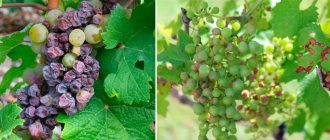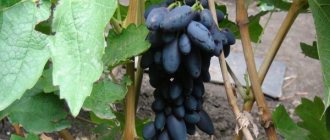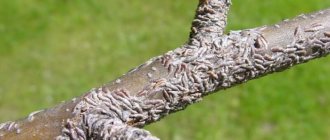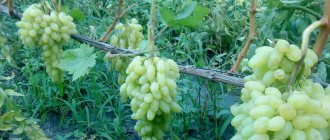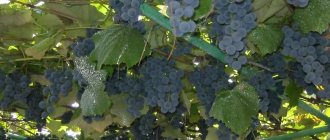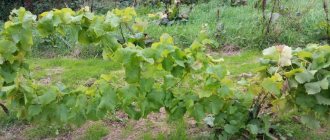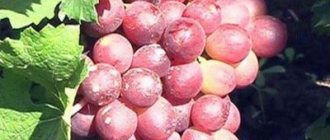Description of the variety Senator Burdaka
This hybrid is completely new, so little is known about it:
- The berries of the variety are greenish, closer to white, in color, very large (weighing up to 20 g). The fruits have tender and juicy pulp, covered with a thick skin. The taste is harmonious and refreshing, very sweet with a nutmeg aftertaste;
- The plants are large and strong, with thick stems. The leaves are large, bright green in color;
- the clusters are also large and dense, similar in shape to a cone. The weight of each bunch reaches 1.2 kg;
- the hybrid is characterized by good frost resistance and resistance to most ailments and insect pests;
- the fruits ripen in August, are well stored and transported over long distances without losing their appearance and taste;
- The variety gives a good and stable harvest.
Senator Burdaka, photo:
To get decent yields of Senator grapes, you need to plant the plants correctly:
- the culture prefers light, elevated areas, well protected from the cold wind;
- groundwater should not be closer than 2.5 meters from the surface of the earth;
- seedlings are planted in the fall, before frost sets in, and in the spring, after the soil has warmed up well;
- Senator grows in fertile, loose, well-permeable soils;
- before planting, prepare the site ahead of time - dig up the ground, remove weeds and roots, fertilize with organic and mineral substances;
- then, two weeks before the intended planting, make holes measuring 80 x 80, drainage is placed at the bottom, then half filled with a mixture of fertile soil taken from above, with a handful of potassium sulfate and superphosphate with the addition of 2 buckets of humus;
- on the surface of this mixture they form a small hill on which the seedling is placed, spreading its roots well, and covered with earth;
- compacted, watered with 2 buckets of water and covered with mulch - humus, compost, peat or rotted manure;
- the distance between bushes must be at least 4 meters;
- Before planting, the roots of the seedlings are placed in a solution of a growth stimulator for several hours.
Plant care is normal. It consists in:
- watering carried out in autumn and spring. If the summer turns out to be hot and dry, then additional moisture is added as the soil dries out;
- feeding Young plants are fed with nitrogen-containing substances. Next, both mineral complexes and organic matter are used, for which an aqueous solution of chicken droppings or rotted mullein is well suited;
- weeding and loosening. The soil around the plants is freed from weeds and organic residues, which may contain fungal spores, various bacteria and larvae of insect pests. Loosen the soil so that oxygen can freely pass to the root system;
- pruning, with the help of which the bushes are cleared of weak, diseased and damaged shoots, and also form the crown and regulate the yield;
- garter to trellises, thanks to which plants grow and bear fruit better;
- shelter for the winter. In regions with cold winters, plants of the variety must be covered. They are carefully untied from the supports, laid on the ground and covered with either spruce branches or covering material, and sprinkled with earth on top.
Growing rules
Grapes need well-lit areas where there are no drafts. It is better to plant in fertile, light soil, where the plant gives the best yield. It is better to plant planting material in the spring, when there is no risk of winter frosts.
Selection of seedlings
Seedlings are purchased from nurseries after grafting. The optimal age of planting material suitable for cultivation in all regions of the country is 1-2 years. These seedlings quickly get used to different climatic conditions.
Landing Features
Plants must be tied up
Since autumn, they have been preparing a place for planting. The dimensions of the holes should be 80x80 cm. The soil is fed by pouring a bucket of compost or peat into the hole. In the spring, a few days before planting, a drainage system is installed. This allows air and nutrients to circulate better within the root system. A mound is made in 2/3 of the hole, into which the roots of the seedling are introduced. The remaining part is sprinkled with fertile topsoil and watered with 20 liters of warm water. Due to the intensive growth of the plant, a support is installed next to it and a garter is attached to it. The inter-row space should be 3 m, and the distance between bushes should be 2 m.
Agricultural technology
Planting cuttings
Senator grapes prefer light and nutritious soils that have good air permeability. It is better to choose a planting site on the south or south-west side of the site; a small slope is ideal. Like any grape, Senator needs protection from north and draft winds, so planting chibouks along a wall or fence is encouraged.
Recommendations for planting grapes are as follows:
- The Senator can be planted both in holes and in trenches. The dimensions of the planting holes are usual: 60x60 cm. The depth of the trench should be the same.
- It is advisable to prepare the landing site in advance. If cuttings are supposed to be planted in the spring, then the pit is prepared in the fall. In extreme cases, at least two weeks should pass from the moment of creating the hole to planting the grapes.
- If the groundwater in the area is high, drainage is required. The bottom of the hole or trench is covered with a thick layer of broken brick, expanded clay, and crushed stone. A little coarse sand is poured on top.
- After drainage there should be a fertile layer (at a level of 40-50 cm). To do this, fertile soil extracted from the pit is mixed with organic or mineral fertilizers.
- It is recommended to soak the roots of grape seedlings before planting. They are soaked for a day or two in ordinary water with a small content of potassium permarganate or in a special growth stimulator.
- Immediately before planting, you need to trim the roots of the cuttings and remove damaged shoots.
- The seedling is placed in the center of the hole and its roots are gradually covered with earth. After planting, the soil must be compacted and watered thoroughly.
Advice! It would be a good idea to preserve the roots of the grape cuttings using a clay mash before planting.
Rules of care
Raising either of the two Senators is not difficult. Therefore, these varieties are excellent even for beginner winegrowers.
All grape care will consist of the following:
Regular watering until the cuttings are completely engrafted. Subsequently, the vine needs to be watered during periods of drought when the soil is very cracked
It is very important not to overdo it with watering, as excessive moisture can cause cracking and rotting of the grapes. It is better to mulch the soil around the vine. This will help protect the roots from overheating in summer and freezing in winter, and will additionally fertilize the soil. You can feed the Senator with slurry, bird droppings, and mineral complexes for grapes
Like all hybrids, Senator accepts fertilizers dissolved in water well. It is better to prune grapes in the spring. For Senator varieties, long (7-8 eyes) or medium (5-6 eyes) pruning is suitable. The first time the vine is pruned immediately after planting or next spring. Despite the persistence of the grapes, they need to be sprayed several times a season. To do this, you can use Bordeaux mixture, Topaz or Ridomil Gold. In the northern regions, the Senator variety needs to be covered for the winter.
Advice! Don't forget about rationing the bush. Large and heavy clusters can break off the vine if their number and location are not regulated. No more than 1-2 bunches are left on each shoot.
Ivan Pavlovich
This year my Senator Pavlovsky bears fruit for the first time (three years have passed since planting). I can say that the variety is very tall; I carry it in two arms, each with ten arms. Over the course of a year, the growth of the vine turned out to be twenty centimeters. I really liked the taste of the grapes, sweet with a strong nutmeg. The only drawback that I have identified for myself so far is that the bunches are too dense. But I think this situation will improve when the load on the bush increases.
Irina
There are a lot of varieties and hybrids growing in my vineyard, and last year I got new grapes, Senator Burdaka. The most difficult thing was to find a seedling, because the variety had just appeared, and there was not even an exact description of it yet. So far I like this hybrid: the cutting took root quickly and well, immediately began to grow, and in the spring it gave off side shoots. I will wait for the harvest and hope that all my labors are not in vain.
Rooting cuttings and planting in the ground
At the end of February and beginning of March, the grapes emerge from dormancy and are able to begin to vegetate; from this moment the process of rooting the cuttings can begin. First of all, the cutting must be checked for suitability and prepared for cultivation; for this you need:
- check the condition of the bark, it should be uniform in color, free of stains and mold;
- cut a small piece of the cutting; when cut, the color of the wood should be bright green;
- cut off the eye to check the viability of the bud; the cut should also be green, without spots or black dots;
- the first bud should be no more than 1.5-2 cm from the base of the cutting;
- Make small cuts in the bark along the perimeter of the base. Roots will subsequently grow from these cuts.
After checking the cuttings, you can begin to germinate them and then plant them as seedlings. To do this, you must follow the following sequence of actions:
Place cotton wool at the bottom of the jar and pour a small amount of water, the layer should be no more than 2 cm
Add water as it evaporates, but watch the amount; there should not be too much water. Important! To germinate, roots definitely need oxygen; if you pour a lot of water, leaves will appear on the cuttings, not roots.
Pour paraffin or wax over the cuttings, this will significantly speed up the process of root formation. Place the cuttings in a jar and leave for 2-3 weeks in the sun. After the specified period, the cuttings will begin to grow, leaves and the first roots will appear. If a leaf appears on the first bud, it can be removed. After the roots have reached a size of approximately 0.5 cm
cuttings can be transplanted into the ground for seedlings. The roots are very fragile, and therefore you should not overexpose them in water, as they will break off during transplantation. The soil is prepared as follows: mix earth or humus with sand in a ratio of 2:1, i.e. For 2 parts of soil you will need 1 part of sand. It is necessary to achieve a loose soil condition.
The soil is poured into small pots; cut plastic water bottles are often used for this purpose. A hole is made in the center in the form of a large depression. You can use a nail, knife, awl, or anything long and thin. It is necessary to make drainage at the bottom of the container so that the water leaves and does not stagnate in the ground.
The cuttings are carefully placed in the prepared recesses. Since the roots are very fragile, under no circumstances should you move, rotate or actively move the cutting in the ground. Carefully place it and slowly add soil in a circle, periodically adding a small amount of water. Important! You can take any water, but before watering it must sit for at least a day.
You need to water the cuttings as needed, depending on the temperature and humidity.
The Senator grape is a very sun-loving plant. It is best to plant in close proximity to the house on the south side. Add humus and mineral, potassium or phosphate fertilizers to the soil.
Planting grape seedlings in open ground:
- It is necessary to dig a trench in the prepared soil, about 15 cm wide and 20-25 cm deep. The depth should be such that the seedlings sink down to the second bud.
- Before planting, water the seedlings to give plasticity to the soil so that it does not crumble. The planting hole also needs to be watered and allowed to soak.
- Remove the seedling from the container for seedlings along with a lump of earth at the roots. Be sure to ensure that the soil does not crumble and the roots do not break off.
- Next, place the seedling at the very beginning of the trench and carefully cover it with soil. If the hole is too deep, you can simply add earth to the bottom. Do not completely fill the planting hole.
- Plant the seedlings one after another along the entire length of the planting hole at a distance of 10 cm.
- After all the seedlings are planted, they must be watered abundantly.
Variety Senator Pavlovsky
E. Pavlovsky obtained Senator grapes by crossing two varieties: Gift to Zaporozhye and Chocolate. The hybrid showed not only high taste, but hardened immunity to many viruses and insects.
Ripening period
The growing region affects the timing of grape ripening, although the variety is considered early. In the southern regions, the period from the beginning of the growing season to the beginning of harvest lasts 125 days; in colder climates it increases to 135–140 days. On average, you can enjoy the harvest in the second half of August.
Characteristics of the bush
The shrub has a high survival rate, has strong trunks that branch little, but form an impressive crown. The leaves are large, carved with pronounced green veins. The flowers are bisexual, so they do not require additional pollination.
Berries
The fruits are large in size and cannot be peeled. The berry is oval in shape, similar in color to ripe cherries; when fully ripe, the weight can reach 18 g. The presence of seeds depends on weather conditions and the region of growth, on average there are 2 - 3 pieces in a grape. The fruits are covered with a thin but elastic skin that does not crack during transportation.
Bunch
The arches of the grapes, tightly adjacent to each other, form a large cone-shaped brush. The weight of the bunch varies from 750 to 1500 g and depends on the quality of mineralization and watering. If wet weather prevails during the ripening period, the formed clusters should be tightly covered with a fine mesh to prevent the berries from cracking.
Taste
The berries have a sweet taste with a pleasant nutmeg tint. The rich aroma is combined with juicy pulp, which melts in the mouth thanks to its delicate, slightly elastic texture. Productivity: every year the Senator Pavlovsky grape variety produces a stable harvest, which can increase or decrease due to the conditions of the vine, as well as its protection from various diseases and pests.
Frost resistance
The grapes are recommended for planting in regions with warm and temperate climates, where the thermometer in winter does not fall below 24 degrees. To protect yourself from freezing of the vine, you need to prepare the grapes for the winter season, protecting them from cold winds and frost.
Disease resistance
This species has a high coefficient of resistance to fungal and viral diseases. The breeder intended to create grapes with high immunity, so oidium and gray rot are not scary for Senator Pavlovsky, and with timely preventive measures against mildew and anthracosis, the risk of infection becomes minimal. The main advantage of this species is the indifference of wasps to it; despite the tart aroma and juiciness of the berries, insects do not fly up to the hybrid.
Clusters of grapes can retain their presentation for a long time and be transported over long distances thanks to the elastic fruits located close to each other. Indicators may change due to high humidity, due to which the berries crack and begin to rot.
The advantages of the Senator grape variety obtained by Pavlovsky are as follows:
- high survival rate of young cuttings;
- resistance to low temperatures;
- high-quality and large harvest;
- equal size of berries and large clusters;
- transportation over long distances is possible, provided that the brushes have not been exposed to strong humidity;
- high commercial qualities;
- resistance to many diseases and insects;
- easy care;
- suitable for making wine
Like all plants, grapes have their drawbacks:
- cracking of berries and spoilage of bunches due to contact with water;
- loose pulp lacking the traditional grape crunch;
- in the northern regions preparation for winter is necessary
Before choosing grapes for your garden plot, you need to compare all the pros and cons in order to choose the most suitable option.
Agricultural technology
Reviews from winegrowers about both Senators are positive: everyone likes the unpretentiousness of these hybrids, their rapid growth and ease of propagation. Given the same ripening periods and similar characteristics, Senators Burdak and Pavlovsky need similar agricultural technology.
Planting cuttings
Senator grapes prefer light and nutritious soils that have good air permeability. It is better to choose a planting site on the south or south-west side of the site; a small slope is ideal. Like any grape, Senator needs protection from north and draft winds, so planting chibouks along a wall or fence is encouraged.
Recommendations for planting grapes are as follows:
- The Senator can be planted both in holes and in trenches. The dimensions of the planting holes are usual: 60x60 cm. The depth of the trench should be the same.
- It is advisable to prepare the landing site in advance. If cuttings are supposed to be planted in the spring, then the pit is prepared in the fall. In extreme cases, at least two weeks should pass from the moment of creating the hole to planting the grapes.
- If the groundwater in the area is high, drainage is required. The bottom of the hole or trench is covered with a thick layer of broken brick, expanded clay, and crushed stone. A little coarse sand is poured on top.
- After drainage there should be a fertile layer (at a level of 40-50 cm). To do this, fertile soil extracted from the pit is mixed with organic or mineral fertilizers.
- It is recommended to soak the roots of grape seedlings before planting. They are soaked for a day or two in ordinary water with a small content of potassium permarganate or in a special growth stimulator.
- Immediately before planting, you need to trim the roots of the cuttings and remove damaged shoots.
- The seedling is placed in the center of the hole and its roots are gradually covered with earth. After planting, the soil must be compacted and watered thoroughly.
Rules of care
Raising either of the two Senators is not difficult. Therefore, these varieties are excellent even for beginner winegrowers.
All grape care will consist of the following:
Regular watering until the cuttings are completely engrafted. Subsequently, the vine needs to be watered during periods of drought when the soil is very cracked
It is very important not to overdo it with watering, as excessive moisture can cause cracking and rotting of the grapes. It is better to mulch the soil around the vine. This will help protect the roots from overheating in summer and freezing in winter, and will additionally fertilize the soil. You can feed the Senator with slurry, bird droppings, and mineral complexes for grapes
Like all hybrids, Senator accepts fertilizers dissolved in water well. It is better to prune grapes in the spring. For Senator varieties, long (7-8 eyes) or medium (5-6 eyes) pruning is suitable. The first time the vine is pruned immediately after planting or next spring. Despite the persistence of the grapes, they need to be sprayed several times a season. To do this, you can use Bordeaux mixture, Topaz or Ridomil Gold. In the northern regions, the Senator variety needs to be covered for the winter.
Caring for young and mature vines
Caring for grapes is easy. But it is necessary to carry out a certain list of measures in a timely manner to allow the seedling to develop and bear fruit normally. There is a difference between caring for a newly planted plant and a mature one.
Caring for the seedling after planting:
You can mulch the grapes around the trunk with seed husks, straw or dry grass. This will increase the survival rate of the seedling, insulate it, retain moisture in the soil and prevent the appearance of weeds; as soon as the vine reaches 0.3-0.4 m, it needs to be tied up. To do this, stakes are driven in from several sides and connected with wire or thick thread so that the bush does not fall
For normal development of grapes, two shoots are enough; It is recommended to water at least once a week, since the soil layer from the rhizome to the surface is quite thin; It is important to cut off excess shoots immediately so that they do not inhibit the growth of the main shoot;
You need to fertilize the soil as needed. If it is fertile, then the initial complex of fertilizers when planting in the first year of life will be quite sufficient; Throughout the growth of Senator grapes, it is recommended to spray them with special products against the most common diseases and pests
It is better to prevent a disease than to treat it later; It is recommended to mint young shoot tips with young foliage no more than 20-30 cm. The best time for this would be the end of August and the beginning of September; In order for the seedling to successfully survive the winter, it is covered with a plastic bucket and buried 0.1 m deep with earth.
Caring for the seedling after the first harvest and until maturity:
To begin with, it is important to correctly mold the fruit section. All kidneys are removed except the top three
In fact, you only need two, but the third is used as a spare. The lower bud should go outward from the bush. It will allow the formation of a fruit link next year. While the top one is in the current one; all shoots that appear in the summer should be periodically tied up; excess shoots and buds are removed; stepsoning must be done on time; Before flowering, pinching is done, the main purpose of which is to create optimal conditions for the development of the bunch during flowering; immediately before flowering, the grapes are processed for additional nutrition of the vine and as preventive measures against the appearance of diseases; bunch normalization involves removing excess units so that there are two bunches per shoot.
Stepping after the first harvest is a mandatory procedure
Processing of grapes after harvest:
before the onset of winter, it is important to treat the grapes against the appearance of diseases and pests; It is best to feed the bushes by spraying; It is important to keep the soil moist.
Before winter, grapes should be prepared:
- prune old perennial shoots, leaving new mature vines;
- if these are young seedlings, or there is such an opportunity, the grapes are covered with a box.
It is not difficult to care for grapes; if you do it in a timely manner, you are guaranteed a good harvest.
Grapes Senator
The Senator grape variety is essentially a table hybrid form of amateur selection. It belongs to the authorship of the Russian E.G. Pavlovsky, who bred more than a dozen varieties that were perfectly zoned for the Rostov region.
Senator was obtained by crossing Gift to Zaporozhye and Maradona. A very beautiful variety with bright large berries with a strong muscat taste.
Description
Its clusters weigh about a kilogram and have an attractive appearance. The berries are large, weighing 12-15 grams. Their color is pink-red with different shades and intensities. The fleshy flesh is combined with a thin skin, and the distinct aroma of nutmeg sets it apart from other varieties.
Experienced tasters say that it tastes similar to Muscat of Hamburg. The ratio of sugars and acids in the taste is harmonious. Transportability is good and marketability is exceptional. The ripening period of this beauty is average, 125-135 days, the harvest is harvested in late August or early September. The bunches can hang on the bush longer without loss of taste.
The yield is average and this indicator has not yet been fully studied, since there are few statistics on adult bushes. Winegrowers also have complaints about the density of the bunches: sometimes, due to the fact that it is high, the berries crack and rot.
Senator Pavlovsky's own root plants show great growth vigor. The flowers are bisexual, which facilitates high-quality pollination, so that the berries do not fall apart. Frost resistance is about -23°C, that is, in regions with frosty winters it is advisable to remove it from the trellis and cover it. Grape growers use improvised materials for this, laying poison for mice so that rodents do not damage the vine.
| Color | crimson |
| Form | rounded |
| 12 g / 1.1 kg | |
| 4,8 / 5 |
| Term | early-middle |
| big | |
| -23°С | |
| average |
Care and reproduction
As you know, grapes are often affected by fungal diseases - oidium, mildew, gray rot. The variety in question exhibits average resistance to them. Preventive spraying is a must. Typically, fungicides are applied at the 3-5 leaf stage, before and after flowering.
In hot summer conditions, it is better for the clusters to be hidden from the scorching sun under the leaves. Modern pink-colored hybrids often color more intensely in partial shade.
Cuttings root well, so Senator can be grown in its own root form. It prefers fertile and light soils, and places that are well lit and protected from strong winds. Slopes with southern exposure are suitable. Data on the density of the bunches and the resistance of the berries to cracking after rains is still being studied. Different soils, rootstocks or self-rooted bushes can produce different results.
Whiteberry Senator
Just a few years ago, the namesake of the hybrid form in question appeared in Ukraine. White-berry Senator was bred by an amateur Alexander Vasilyevich Burdak by crossing Talisman and Arcadia. It is announced by the author as a new product for 2021 and is still subject to variety testing. For this, in fact, experimental gardeners from different regions buy it, so how the hybrid form will behave in specific conditions can only be known over time.
Senator Burdak has even larger berries, weighing up to 20 grams. Their color is milky white, and the nutmeg is more subtle than strong. The flower type is female.
Some secrets of the worthy Senator on video:
https://youtube.com/watch?v=YdFXsj61dGk
History of the origin of hybrids
The first Senator was bred by the Russian breeder Pavlovsky about ten years ago. This grape is called Vitis Senator or Pavlovsky Senator. It was possible to obtain a new hybrid after crossing two popular varieties: Gift of Zaporozhye and Maradona.
Just a couple of years ago, an amateur breeder from Ukraine crossed the Talisman and Arcadia varieties, and he also named the resulting hybrid Senator. The breeder's surname is Burdak, which is why his variety is popularly called Senator Burdak. This grape has not yet undergone experimental research, so its characteristics are very conditional. But this circumstance does not prevent winegrowers from actively purchasing seedlings of Senator Burdak and trying to grow this successful hybrid.
Attention! If the cuttings you buy are called “Senator,” most likely this variety is Senator Pavlovsky. This needs to be clarified with the seller or asked what color the berries are (the Pavlovsky variety is considered pink-fruited, while Burdak bred white grapes).
A masterpiece of Moldovan selection - Senator grapes
What can you say about this masterpiece of Moldovan selection? Not a beauty, that's for sure - the clusters are very dense, dirty-reddish, not very pleasing to the eye.
If this scares the buyer away, offer him a taste of the berry - one hundred percent, he’ll buy it and come back tomorrow! It is simply impossible to remain indifferent to such berries!
What type does it belong to?
Senator is a hybrid table subspecies with early-medium ripening period. Table hybrids also include Zarya Nesvetaya, Russian Korinka and Valery Voevoda.
The berries ripen by early autumn. Usually they are left to hang out so that more sugar accumulates. The berry tolerates storage and transportation well.
It is especially popular among winemakers for its rich, unfolding Muscat bouquet with sour, sweet and tart notes, and a rich aftertaste with a hint of strawberry. It is also very popular fresh - the berries can be stored for a long time without losing nutmeg, which is especially valuable.
Summer Muscat, Novoshakhtinsky Muscat and Podarok Nesvetaya can also boast nutmeg taste and aroma.
Senator grapes: variety description
Height strength is above average. It has good survival rate of cuttings. The bunch is moderately large, round, very dense, on a long light green stem.
Pea peas are observed very rarely. Weight from 600 g to one and a half kilograms. The berries are oval or ovoid, quite large, 10-12 g, dirty pink or light red with purple.
The skin is dense, you can hardly feel it when eating. The pulp is juicy, fleshy, with two or three small full seeds inside.
Photo of Senator grapes:
History of selection
Created by E.G. Pavlovsky, whose main goal has always been to create grapes that are not too afraid of winters and resistant to diseases. At the same time, so that it retains its sweetness and exquisite aroma.
The senator became such a gift for winegrowers. Parent varieties are Podarok Zaporozhye and Maradonna.
It belongs to the covering varieties, so it is best, of course, in the south - Crimea, Don region, Caucasus, Krasnodar region. Not common in mid-latitudes due to possible harsh winters, which can be fatal to the Senator.
Romeo, Sponsor and Pharaoh belong to the hand of the same breeder.
Characteristics
This “dignitary” tolerates frosts very well (although it requires that it be covered) - down to -23-24 degrees Celsius. It is also afraid of strong sunshine - the bunches need to be covered with leaves so that the berries do not get sunburn. Not afraid of fungal attacks.
According to reviews from farmers, phylloxera is also not afraid. Well compatible with most rootstocks, loves additional care - watering, fertilizers. The ripening of the shoots is very good, almost the entire length. Wasps, according to gardeners, are also practically unharmed.
Diseases and pests
The likelihood of such a formidable disease as bacterial cancer is low, but it still exists. Grape oncology is a very terrible enemy; if you miss it, you can easily lose the entire vineyard. Moreover, unfortunately, they have not yet learned how to treat it.
Or rather, chemists have invented drugs that, according to them, will cure bacterial cancer completely, but they are still at the experimental stage. Therefore we will have to cope with what we have.
The main weapon in the fight against any cancer is prevention.
This means that we carefully examine the cuttings and seedlings, feed them with mineral fertilizers, and handle them with extreme caution so as not to cut the bark
You will also have to make sure that the bush is well blown with fresh air. Well, if the disease does come, the diseased part is uprooted and destroyed.
Do not neglect prevention against anthracnose, bacteriosis and chlorosis. Despite the resistance to fungi, do not forget to inspect for the appearance of mildew and oidium, all kinds of rot.
The one that will definitely come to eat is the felt mite, otherwise known as grape itch. It eats shoots, leaves, ovaries and berries. Therefore, the vineyard needs to be sprayed with preparations - Bi-58, Fufanon, Kleschevit, Tiovit-Jet is also good.
Senator grapes are a real miracle of selection, a gift to all winegrowers, especially those who know a lot about good wine. Outwardly, the bunch may not amaze with its beauty, but it is not for nothing that they say that the one with the most handsome face is not the good one.
It is enough to try this berry once to want to enjoy it all year round. And this variety, despite its “status” name, does not require complex care, but the most ordinary care that any gardener is familiar with.
You can see the Senator grapes more clearly below: https://www.youtube.com/watch?v=YdFXsj61dGk
If you find an error, please select a piece of text and press Ctrl+Enter.
Diseases and pests
The senator grape variety, like many other varieties, suffers from the effects of certain pests or diseases. What should you be wary of when growing these grapes?
- Birds. No matter how paradoxical it may sound, birds are one of the main enemies of the variety. It is possible to save the crop from birds - for this purpose, they install a mesh fence of increased rigidity and strength.
- Bacterial cancer. The likelihood of developing this disease is low, but still present. If you do not notice the first symptoms of the disease, you can not only lose the harvest, but the entire vineyard. There is no cure for grape cancer yet. Prevention may be the best weapon. In order to carry out preventive measures, each cutting or seedling must be carefully examined before planting. You should be careful with the integrity of the bark - damaging it is highly discouraged. In addition, it is necessary to choose a place where the bushes will be well ventilated due to the supply of fresh air. If the disease does occur, the damaged bushes are dug up and destroyed.
- Grape itch. It is also called felt mite. This pest loves almost everything in grape bushes - berries, ovaries, leaves, shoots. To cope with this pest, the vineyard must be sprayed with drugs such as Kleschevit, Bi-58, Tiovit-Jet, Fufanon.
- Fungal diseases. According to the description, vineyards are often infected with gray rot, mildew and oidium. The senator has a good track record of resistance to these ailments. But it is simply necessary to carry out preventive spraying. Fungicides are usually applied at a time when the plant already has 3 to 5 leaves. Spraying is carried out before flowering and immediately after it.
Grape itch (felt mite) on a grape leaf
Valek grapes
From crossing Rizamat, variety Kesha 1 and grapes Zvezdny amateur breeder N.P. Vishnevetsky received the Valek grapes, which ripened in just 105 days. The plant in its own root culture is characterized by a high growth rate, excellent yield and ripening of annual growth. The vine tolerates winters with temperatures not lower than –24 °C without significant losses, and is rarely infected with pathogenic fungi and rot.
The grape variety is distinguished by the friendly formation of the ovary even in years with unfavorable weather conditions. At the same time, massive brushes are formed on the bushes, sometimes reaching a weight of up to 2.5 kg and having a very attractive appearance for the consumer.
The berries, weighing about 15 grams, have a fleshy texture, an attractive yellow color and an unusual pear flavor. Muscat tones are clearly visible in the sweet taste of Valek grapes. The bunches can be transported and stored without harm to the berries.
Shelter for the winter
Frost poses a danger not so much to the shoots as to the roots. Therefore, when covering, the emphasis is on mulching the ground. In November, straw is laid on dry soil in a layer of at least 3-4 cm. The vine is removed from the trellis and buried in the straw. Cover the grapes with agrofibre on top of the mulch. Now the crop will survive even a harsh winter with temperatures down to -30 degrees.
Tastes of products
Senator - products aimed at an esthete, a person with good taste and money
The line of flavors contains classic and subtle options, which attracts attention to the brand from both men and women
There are 3 classic flavors:
- winegrape;
- Grand Virginia;
- Original Pipe Tobacco;
Traditionally, they are sold in metal cigarette cases with a unique color and uniform design. Each flavor is produced in additional series, differing in nicotine and tar content:
- Nano;
- Nanopower;
- Slims.
The types of cigarettes produced in these series are identical to the original flavors. The only difference is in the packaging - now it’s an ordinary cardboard box.
The types listed above are not the only ones. Today the Senator brand offers a wide range of aromatic models to choose from. However, it is the classic tastes that deserve special attention. Each of them has its own design, aroma and composition. And each one is worth dwelling on in more detail.
